Swamimalai Murugan Temple is a Hindu temple located in the township of Swamimalai, 5 km from Kumbakonam on the banks of a tributary of river Cauvery, 250 km from Chennai and is near to Thanjavur in India.[1]
Contents[hide]
|
[edit]Arupadai Veedu
It is one of the Arupadaiveedu, believed to be the six main abodes of Muruga. According to Hindu belief, Swamimalai is where Muruga preached what as called as "Pranava mantra" to his own father, Shiva, at a tender age, after arresting 'Brahma' for not answering his question about Pranava Mantra. Though this temple is considered as one of the Arupadaiveedu of Lord Muruga, the real Padaiveedu lies at a place called 'Thiruveragam', from where the Lord Muruga idol is brought during the 'Soorasamharam' festival.
[edit]The Temple
In Swamimalai, Lord Muruga is known as "Balamurugan" and "Swaminatha Swami". The speciality of the temple is that it has been built on an artificial hill. In Tamil language, such an artificial hill is called "Kattu Malai". The next important feature is the steps of this small artificial hill. There are 60 steps and each is named in one Tamil year. There are a total number of 60 Tamil years and hence the 60 steps. Another name for this place is "Thiruveragam".
[edit]Legend
The history of the temple known as "Sthala Puranam" is as follows: Once, Lord Brahma, the creator of living beings, had disrespected Lord Muruga (the son of Lord Shiva) at the time of visiting Mount Kailash where Lord Shiva resides. Hence Lord Muruga got angry with Lord Brahma and asked him how he was creating living beings such as people, animals etc. Lord Brahma said that he was creating living beings with the help of the Vedas (The Holy Hinduism Books). On hearing the reply, Lord Muruga asked Lord Brahma to recite the slogams from such Vedas. Brahma started to recite the slogams with the Holy word called Pranav Mantra "Om". At that time Lord Muruga stopped Lord Brahma and asked him to tell the meaning of the Pranava Mantra. Lord Brahma couldn't tell the meaning and hence Lord Muruga knocked Lord Brahma on his forehead with His clenched fists and punished him with imprisonment due to Lord Brahma's ego. With Brahma imprisoned, Lord Muruga took up the role of the Creator. Creation went better than usual, with Lord Muruga presiding over Satya-loka and Lord Brahma's absence was unnoticed. Until one incident which brought the Devas to Satya-loka seeking Lord Brahma caused great surprise to them that Lord Bramha was imprisoned and Lord Muruga wearing the garb of the Creator. They requested Lord Vishnu to negotiate with Lord Muruga in order to release Lord Brahma. Unfortunately, this attempt was not successful. As a final resort, Lord Shiva then went to the rescue of Lord Bramha.
Lord Shiva came to Lord Muruga and asked him to release Lord Brahma from imprisonment. Lord Muruga refused to release him on the grounds, that Lord Brahma was not suitable to do the work, as he did not known the meaning of the Pranav Mantra (Hindi: ॐ AUM). So Lord Shiva asked Lord Muruga whether He knew the meaning Himself and to tell the meaning to him, for he too wished to know Its meaning. To this, Lord Muruga declared that this was the reason why Lord Shiva is the greatest of the Trinity, as he has no ego and willingly gave full respect to him becoming a disciple to Lord Muruga, his preceptor. Lord Muruga extolled to Lord Shiva the meaning of the Pranava Mantra (Hindi: ॐ ) who like a student listened with rapt attention from his beloved Son.
This important and interesting incident happened in Swamimalai and hence Lord Muruga is known as "Swaminatha Swami". The meaning of this name is "The Teacher of Lord Shiva". The Lord Muruga idol is 6 feet in height. There are golden armours, golden crowns and a diamond lance for the Lord.
Arulmigu Swaminatha Swami Temple, Swamimalai
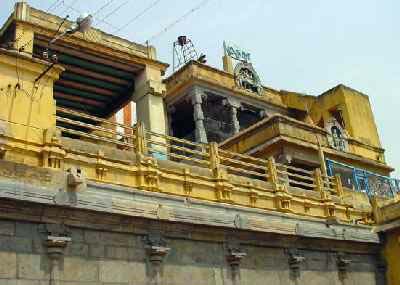 |
Location
Swamimalai is a sylvan village, situated about five kilometers west of Kumbakonam on the banks of a tributary of river Cauvery. The temple is situated very close to the bus stand and the railway station is about two kilometers away. It is well connected to and surrounded by important places like Kumbakonam, Tiruvidaimarutur, Mayiladuthurai, Papanasam, Tanjavur etc.
Mythology and History
Swamimalai is fourth among the sixpadai veedu or sacred shrines dedicated to Lord Muruga. The presiding deity here expounded the meaning of the Pranava mantra OM to his own Father Lord Siva Himself.
Mythology says that saint Bhrugu before commencing an arduous tavam or penance, got the boon that anybody disturbing his mediation will forget all his knowledge. Such was the power of the penance that the sacred fire emanating from the head of the saint reached up to the heavens, and the frightened devas surrendered to Lord Siva praying for his grace. The Lord extinguished the sacred fire by covering the saint's head by hand. With the saint's penance thus disturbed the Lord became oblivious of all his knowledge and is said to have regained them by learning the Pranava mantra from Lord Muruga at this shrine.
Once when Brahma, the lord of all creations was proceeding to Kailasa, the ever-playful child Lord Muruga asked him for the meaning of the Pranava OM. When Brahma admitted his ignorance, the Lord imprisoned him. With Brahma imprisoned, all creations came to a standstill and the devas prayed to Lord Siva to get Brahma released. When Muruga insisted that the imprisonment was a just punishment for the ignorance of Brahma, Lord Siva asked him whether he himself knew the meaning of the primordial Pranava OM. Lord Muruga said that he knew the meaning of OM and can expound it to the latter only if he can accept him as guru and listen to the exposition as a devoted disciple. As Lord Siva acceded to the request of Lord Muruga and heard the exposition of OM as a disciple, the place came to be known as Swamimalai and the presiding deity as Swaminathan.
The temple is built on an artificial hillock of about sixty feet height with sixty beautifully laid stone steps representing the Hindu cycle of sixty years - leading to the Lord . In the ground floor there are temples dedicated to Lord Sundareswarer and Goddesss Meenakshi.
Hymns in praise of the presiding deity have been sung by saint Nakkeerar in Tirumurukatrupadai and by Saint Arunagirnathar in Tiruppukazh.
Pujas and Festivals
Daily pujas to the deities are performed six times a day (six kalams). Usha Kalam, Kalasandhi and Uchikala poojas are performed in the forenoon and the afternoon poojas commencing from Sayaratchai and Rendam kalam are concluded with Arthajama pooja in the night.
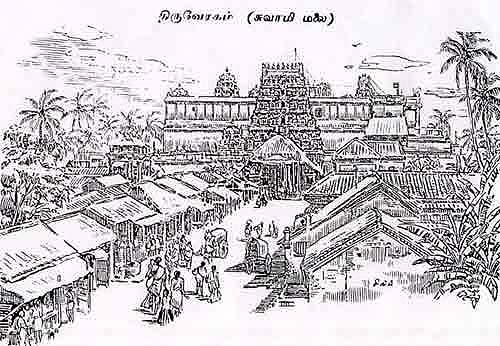 |
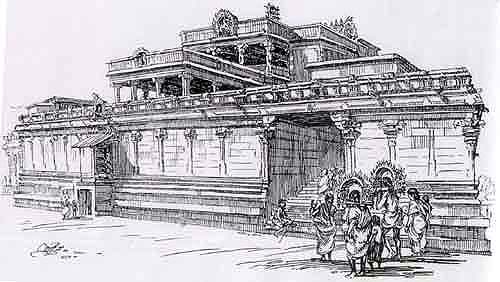 |
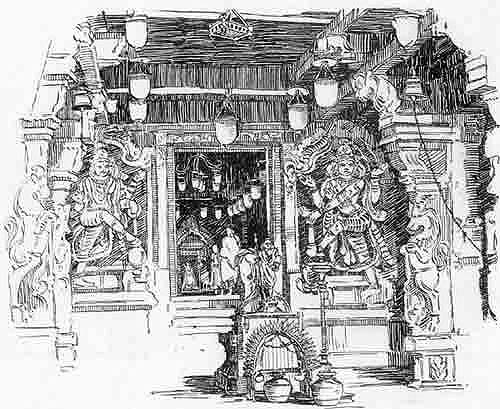 |
The important festivals conducted in the temple are:
- Monthly Kirutikai festival;
- Temple Car festival in April;
- Visakam festival in May;
- Navaratri festival in May;
- Skanda Shashti festival in October;
- Tiru Karthikai festival in Nov/December;
- Taippūcam festival in January; and
- Pankuni Uttiram festival in March.
Golden Chariot
The temple has an imposing golden chariot made of seven kilos of gold, 85 kilos of silver and other metals like copper, beautifully illuminated with electric bulbs.
Devotees on payment of Rs. 1001 can take the deity in a procession in the golden charriot around the outer corridor. Devotees are offered a shawl, eversilver pot and a small box with the Lord's prasadam.
Facilities
For the convenience of the pilgrims and devotees, 11 rooms, four cottages, two VIP cottages, one donor cottages, three marriage halls and one dining hall have been constructed and are let out at nominal rent ranging from Rs. 20/- to Rs. 100/- per day only.
Sub-temples
Among the sub-temples under the administration of the Swamimalai temple, the Sveta Vinayagar temple at Tiruvalanchuli is an important one. The presiding deity Lord Sadaimudinathar and Goddess Perianayaki have been sung by Tirugnanasambandar and Tirunavukkarasar in Tēvāram. A unique feature of this temple is the Sveta Vinayagar or White Pillaiyar made of the sea foam formed at the time of churning of the Milky Ocean by the devas and asuras to get the nectar. The sacred Cauvery River flowing nearby herself has turned around in a right semicircle around this shrine and hence the name Valanchuli or right twist. Renovation of this temple at a cost of Rs. 50 Lakhs is progressing.
Another architecturally beautiful temple at Kilpazhayarai dedicated to Lord Somanathaswami is also under renovtion at an estimated cost of Rs. 50 Lakhs. It is worth mentioning that this shring is the birthplace of Saint Managaiyarkarasi, one among the 63 Nayanmars. Hymns in praise of the presiding deity have been sung by Tirunavukkarasar.
Other sub-temples mentioned below under the administrative control of Swamimalai temple are also to be renovated at a modest cost of about Rs. 5 lakhs each.
- Dharmapureeswarar Temple, Vallalarkoil;
- Chakravageeswarar Temple, Chakkrapalli;
- Ezhutharinathar Temple, Innambur;
- Skandanathar Temple, Tiruerakaram; and
- Thirupandeeswarar Temple, Adanur.
All the above temples along with the Swamimalai temple are administered by an Asst. Commissioner / Executive Officer appointed by the Commissioner, Hindu Religious and Charitable Endowments Dept, Chennai.
All contributions in cash and kind for the renovation of the above temples may kindly be sent to:
Arulmigu Swaminatha Swami Temple
Swamimalai - 612 302
Thanjavur district Tamil Nadu, India
Contact Us
| ||

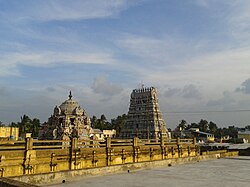
No comments:
Post a Comment